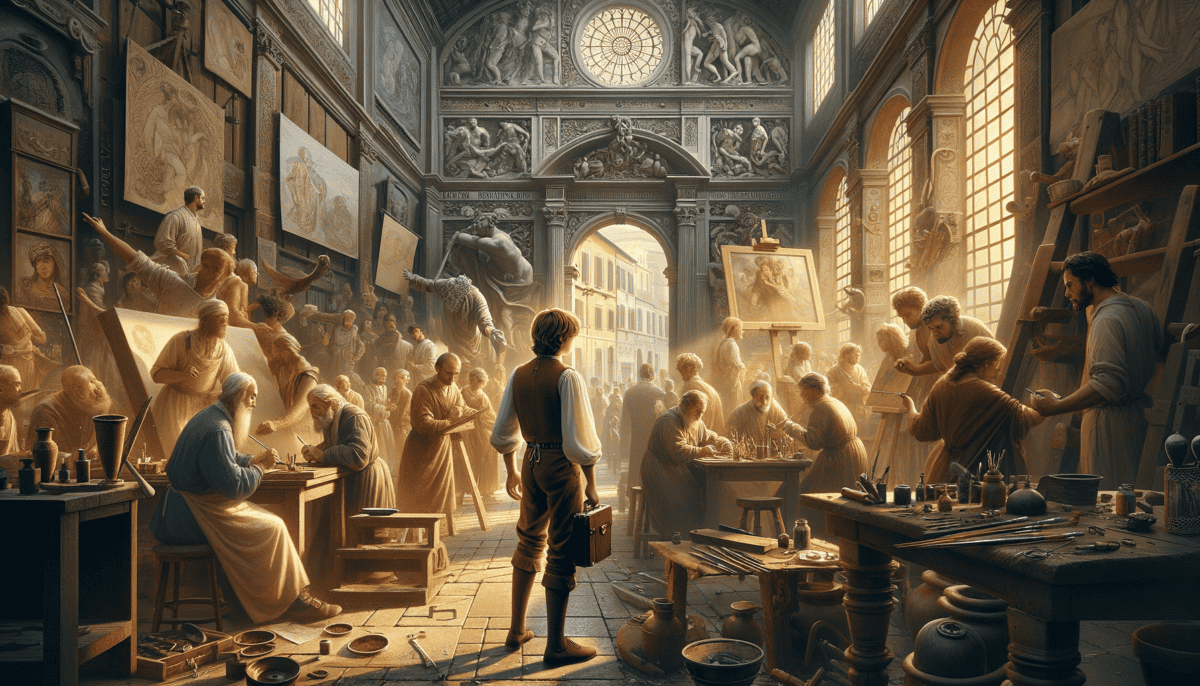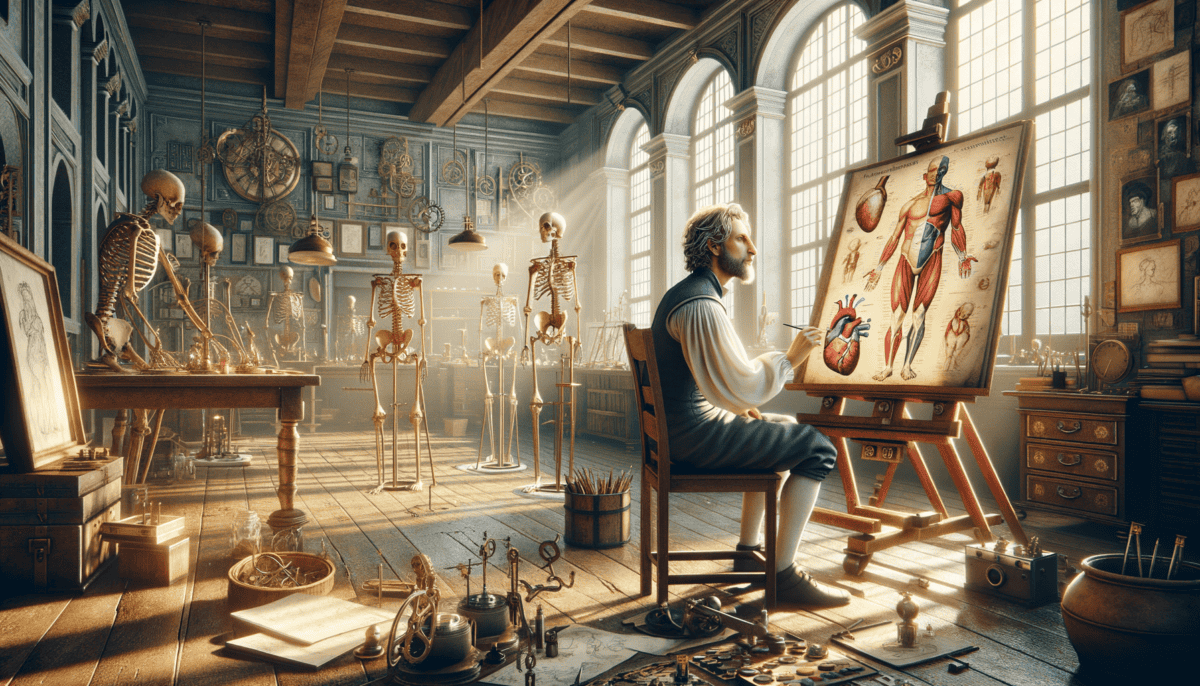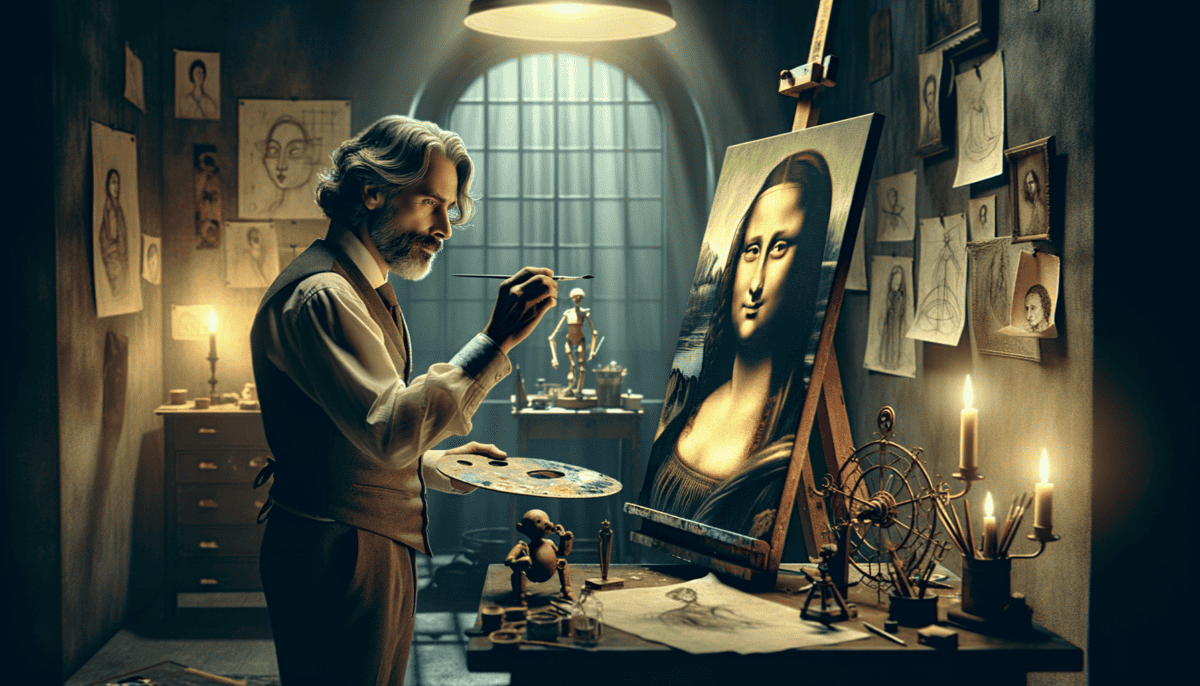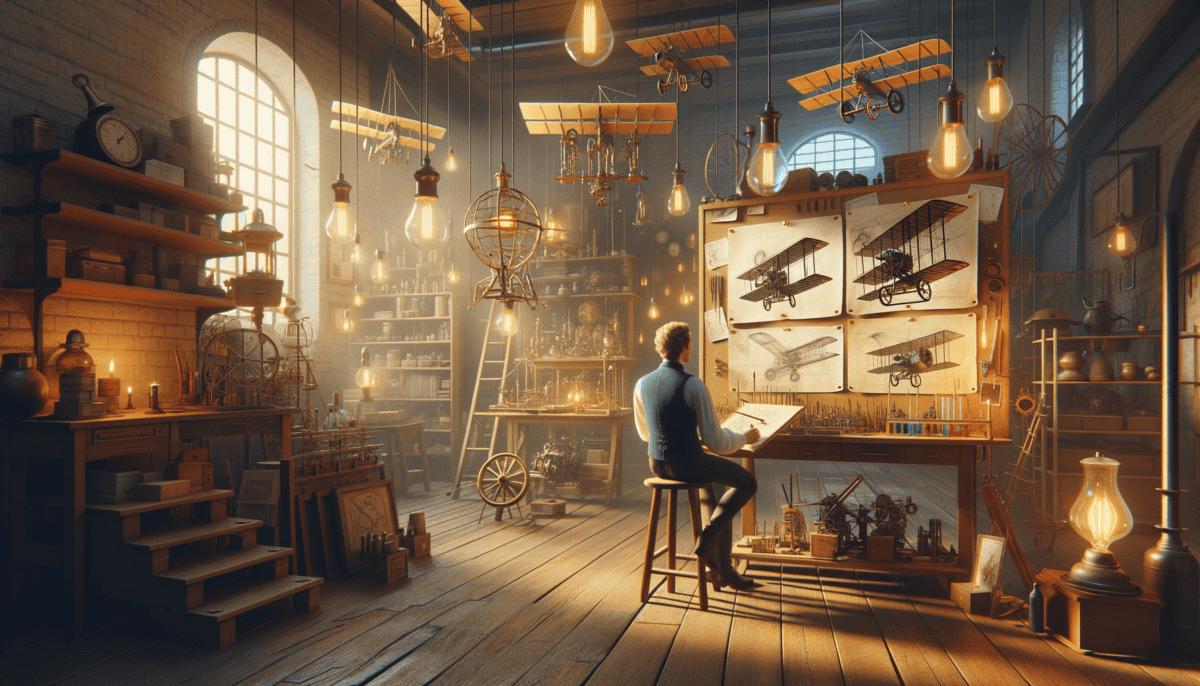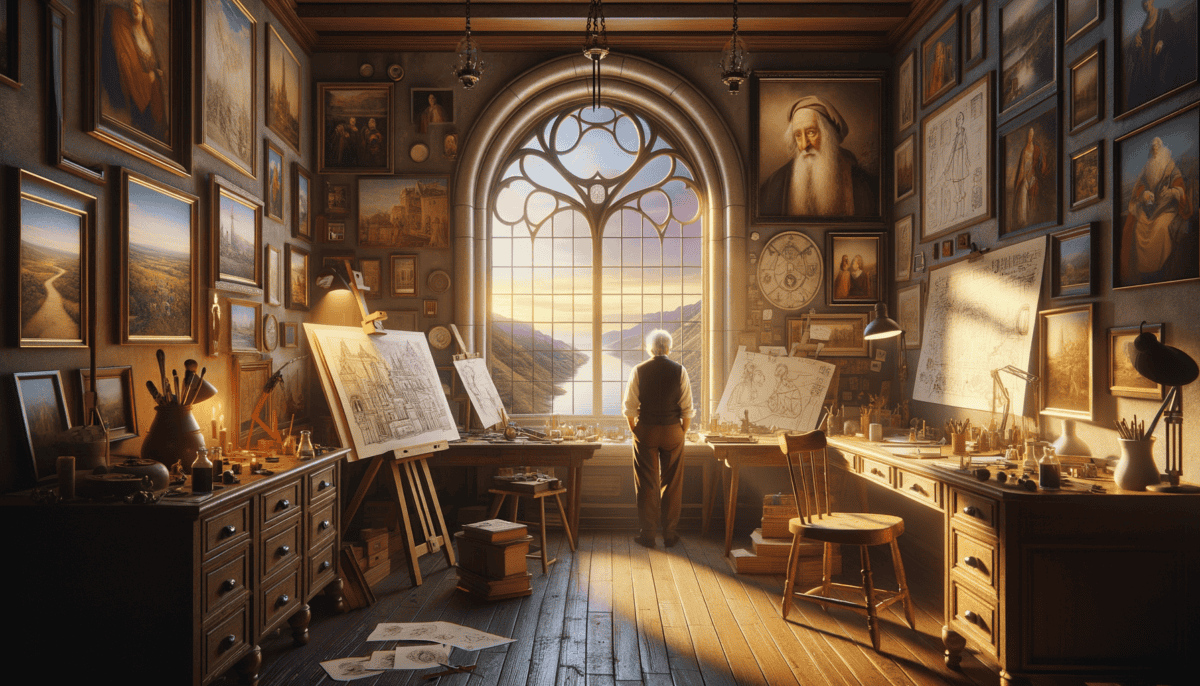A Curious Mind in Vinci
In a small village nestled among the rolling hills of Italy, a special little boy named Leonardo lived with his family. The year was 1452, and the village was called Vinci.
"Look, Papa!" young Leonardo called out excitedly. "The bird's wings move like this!" He waved his arms up and down, trying to copy the dove that had just flown past their window.
Ser Piero, Leonardo's father, smiled at his five-year-old son's enthusiasm. "You notice everything, don't you, my boy?"
Leonardo spent his days watching the world around him with wide, curious eyes. He loved to sit in the garden, studying how flowers opened their petals to greet the morning sun. ✨
"Grandmother," Leonardo would ask, tugging at her skirt, "why do leaves change color? Why does water swirl in circles? Why does thunder make such loud noises?"
His grandmother Lucia chuckled warmly. "You ask more questions than all the scholars in Florence!" But she never tired of his curiosity.
Leonardo wasn't like other children in Vinci. While they played games in the street, he would sit for hours drawing detailed pictures of insects, plants, and animals. His drawings weren't just simple sketches – they looked almost real!
One day, while exploring the hills near his home, Leonardo found a cave. Most children would have been scared, but not him. He stood at the entrance, his heart beating with excitement.
"Should I go in?" he wondered aloud. "What if there are amazing things to discover inside?"
His curiosity won over his fear. With a small lantern in hand, he took a few steps into the cave. The walls sparkled with tiny crystals, and water dripped from the ceiling making musical sounds.
Back home, Leonardo immediately began to draw what he had seen. His father watched in amazement as the cave came to life on paper.
These were the things that made Leonardo special:
- His endless questions about everything
- His careful way of watching nature
- His amazing skill at drawing
- His brave spirit to explore
- His dream to understand how things worked
"Papa," Leonardo said one evening, looking up from his drawings, "I want to know everything about the world."
Ser Piero patted his son's head. "My boy, I think you just might do that."
As the sun set over the hills of Vinci, young Leonardo continued to draw by candlelight. His mind was already filling with ideas that would one day change the world.
In his small bedroom, surrounded by sketches of birds, flowers, and machines that existed only in his imagination, Leonardo dreamed of all the mysteries he would solve. Little did he know that his curious mind would lead him to become one of the greatest thinkers the world had ever known.
The villagers of Vinci often saw the boy sitting by the stream, watching water flow over rocks, or lying in the grass, studying how clouds changed shape. They didn't understand why he spent so much time observing such simple things.
"That da Vinci boy," they would say, shaking their heads. "Always with his head in the clouds."
But Leonardo didn't mind. He knew that understanding nature's secrets was the key to understanding everything. Each day brought new discoveries, new questions, and new dreams of what he might learn tomorrow.
The Young Apprentice
The bustling streets of Florence in 1466 were very different from quiet Vinci. Fourteen-year-old Leonardo walked wide-eyed through the city, taking in all the sights and sounds.
“Welcome to my workshop,” said Andrea del Verrocchio, a famous artist who would become Leonardo’s teacher. The workshop was filled with half-finished paintings, tools, and the smell of paint.
Every morning, Leonardo woke up early to help clean the workshop. But he didn’t mind – there was so much to learn!
“Master Verrocchio,” Leonardo asked one day, “why does the sky look bluer far away than it does above us?”
His teacher smiled. “Ah, you notice things others miss. That’s what makes a true artist.”
The other apprentices sometimes teased Leonardo about his endless questions:
- Why do shadows look blue?
- How do muscles move under skin?
- What makes metal shine?
- Why do birds float on air?
- How does light bounce off water?
But Leonardo kept asking and watching. He studied how cloth folded, how faces showed feelings, and how light danced on water. ️
One day, Verrocchio asked Leonardo to paint an angel in a picture of Jesus being baptized. When it was done, everyone was amazed. Leonardo’s angel was so beautiful that it made the rest of the painting look dull!
“Your angel,” Verrocchio said softly, “it looks like it could fly right off the panel.”
Leonardo didn’t just paint – he watched how things worked. He would spend hours in the market, studying how people moved and showed their feelings on their faces.
“Look at her smile,” he would whisper, quickly drawing a woman laughing at a joke. “See how her eyes crinkle at the corners?”
At night, after everyone else had gone home, Leonardo stayed in the workshop. By candlelight, he practiced drawing the same thing over and over until it was perfect. ✨
“Why do you work so hard?” asked another apprentice.
“Because,” Leonardo answered, “I want to paint things exactly as they are in nature.”
The other boy shook his head. “But why not just copy the old paintings like everyone else?”
Leonardo smiled. “Because nature is the greatest teacher of all.”
As the years passed, Leonardo learned to mix his own paints using special recipes. He discovered that adding tiny amounts of color could make shadows look more real. He studied how birds flew and dreamed of making machines that could fly too.
“Master,” he said one evening, showing Verrocchio a detailed drawing of a flying machine, “do you think humans will ever soar through the sky?”
Verrocchio looked at the careful drawings. “With a mind like yours, Leonardo, anything is possible.”
Soon, people began to notice Leonardo’s special talent. They would stop by the workshop just to see what new thing he was working on. His paintings looked so real that some people thought they might step right out of the frame! ️
But Leonardo wasn’t satisfied with just being good at art. He wanted to understand everything about the world. While painting, his mind would wander to questions about light, motion, and the way things worked.
“Your mind is like a butterfly,” Verrocchio told him, “always floating from one interesting thing to another.”
Leonardo nodded. “The world is full of wonderful mysteries, Master. I want to solve them all.”
Dreams Take Flight in Milan
The year was 1482, and Leonardo had big dreams as he entered Milan. The grand city towers sparkled in the morning sun.
“Look at this magnificent place,” Leonardo whispered to himself, clutching his sketchbook. The streets buzzed with life, very different from Florence.
Duke Ludovico Sforza sat on his throne, looking at Leonardo’s letter. “So, you say you can build war machines for my army?”
“Yes, Your Grace,” Leonardo replied, opening his sketchbook. “And I can paint and sculpt too!”
The Duke’s eyes widened as he looked at Leonardo’s drawings. There were designs for giant crossbows, special bridges, and even tanks!
- Giant crossbows that could shoot big rocks
- Bridges that soldiers could quickly put up and take down
- Special armor that protected horses
- Big moving shields with wheels
- Boats that could go underwater
“You shall work for me,” the Duke declared. Leonardo’s heart jumped with joy!
In his new workshop, Leonardo started many projects. But his curious mind kept jumping from one thing to another. One day he would paint, the next day he would study birds flying.
“Why do you cut up dead people?” asked his helper, making a funny face.
“To learn how bodies work,” Leonardo explained, drawing careful pictures of muscles and bones. “If I know how things work inside, I can paint people better on the outside.”
At night, Leonardo would write in his special notebook, using mirror writing that could only be read in a mirror. He filled pages with ideas:
During the day, he painted beautiful pictures for the Duke. His most famous was “The Last Supper” – a huge painting of Jesus and his friends having dinner.
“Why does it take so long?” the Duke would ask.
“Because each face must tell a story,” Leonardo would answer, carefully painting each tiny detail.
Sometimes Leonardo would stop painting to write down ideas for flying machines. He drew pictures of what looked like helicopters and airplane wings.
“Someday,” he told his helper, “people will fly through the air like birds!”
Many people thought Leonardo was strange for wanting to know so much about everything. But he didn’t mind.
“The more I learn,” he would say, “the more amazing the world becomes!”
Leonardo kept studying and drawing. He learned about plants, rocks, water, and stars. Everything made him curious! ⭐
One evening, while watching water flow in a river, he noticed how it made little swirls.
“Look!” he exclaimed, quickly sketching. “The water dances in circles, just like curly hair!”
His notebooks filled up with drawings of waves, whirlpools, and flowing water. He was always finding connections between different things in nature.
Years passed, and Leonardo became famous in Milan. People came from far away to see his paintings and hear his ideas. But he never stopped learning and asking questions.
The Duke was proud to have such a talented artist and inventor working for him. “Leonardo,” he said one day, “you see the world in a special way.”
Leonardo smiled and picked up his brush. There was still so much to discover, so much to create. His mind was already racing with new ideas for tomorrow’s adventures. ✨
The Mystery Behind the Smile
The sun peeked through Leonardo’s workshop window in Florence. The year was 1503, and a special painting sat on his easel.
“Mona Lisa,” Leonardo called softly to his subject, “please keep that gentle smile.” The lady in the dark dress sat very still, her hands folded neatly in her lap.
“Why do you paint so slowly?” asked his young helper, watching Leonardo add tiny brush strokes.
Leonardo smiled, not looking up from his work. “Every tiny mark matters. See how the corners of her mouth turn up? That’s where the magic lives.” ✨
He mixed his paints using a special technique:
“Layer upon layer, like the way fog settles over hills in the morning. This makes the colors blend like smoke.”
As days turned into weeks, and weeks into months, the painting slowly came to life. Leonardo wasn’t just painting a portrait – he was trying to capture something more.
“Look at the background,” he told his helper. “See how the path winds through those misty mountains? It’s like a dream world.” ️
People would visit his workshop and ask:
“Why isn’t the painting finished yet?”
“When will it be done?”
But Leonardo just kept working, adding tiny details that most people couldn’t even see. He wanted this painting to be special.
Leonardo used all his knowledge to make the painting perfect. His studies of light helped him make the shadows soft. His understanding of faces helped him capture Mona Lisa’s expression.
“Your eyes follow her wherever you go,” noticed his helper one day.
“Yes!” Leonardo exclaimed excitedly. “That’s exactly what I wanted! She watches you, and her smile… it changes depending on how you look at it.”
Sometimes Leonardo would take breaks from painting to write in his notebook:
He carried the painting with him everywhere he went. Even when he traveled, Mona Lisa came too. He worked on it for years and years.
“Why do you keep painting the same picture?” people would ask.
“Because it’s never quite perfect,” Leonardo would answer. “There’s always something more to add, something more to discover.”
The painting became famous even before it was finished. People heard about the mysterious lady with the magical smile.
One evening, as the sun was setting, Leonardo stepped back from his easel. The warm light fell across Mona Lisa’s face, making her smile seem even more mysterious.
“Do you see?” he asked his helper. “She knows something we don’t know. That’s what makes her smile so special.”
Years later, when people asked Leonardo about the Mona Lisa’s smile, he would just smile himself and say, “Some mysteries are better left unsolved.”
And to this day, millions of people visit the Mona Lisa every year, trying to understand the secret behind her famous smile.
Dreams of Flight
The candlelight flickered in Leonardo’s workshop as he bent over his desk, his quill scratching across paper. It was past midnight, but his mind was buzzing with ideas.
“Master da Vinci,” his young assistant Francesco yawned, “why are you drawing birds again?”
Leonardo’s eyes sparkled as he looked up. “Watch how they soar, Francesco. Their wings hold the secret to human flight!” ✨
His notebook pages showed amazing inventions:
• The flying machine with big wings
• A helicopter-like spinning device
• A parachute shaped like a pyramid
• Special suits for flying
• Tools for measuring wind
Leonardo picked up a feather from his desk. “See how light it is? How perfectly shaped?” He twirled it in the air, watching it float down.
“If birds can fly through the air, why can’t people do the same?”
But when he showed his designs to others, they laughed.
“Humans weren’t meant to fly!” they said.
“It’s impossible!” they scoffed.
But Leonardo didn’t listen to them. Every morning, he climbed the highest hill near his home to watch birds soar overhead.
He built small models of his flying machines. Some worked better than others.
“Look, Francesco!” Leonardo called out one day, launching a small wooden glider. “See how it stays in the air?” The little device floated gracefully before landing softly in the grass. ️
He also designed special machines for war:
“A giant crossbow bigger than three men!”
“Boats that can go underwater!”
The rulers who saw these designs were amazed. Duke Sforza of Milan especially liked Leonardo’s war machines.
“But Master,” Francesco asked one day, “why do you make things for war if you love peace?”
Leonardo sighed, putting down his quill. “Sometimes we must design things we don’t like to protect the things we love.” ️
At night, Leonardo would dream of his inventions coming to life. In his dreams, people soared through clouds and boats danced under the waves. ⭐
He wrote his notes backward, like in a mirror, to keep his ideas secret. Only special people could read them.
“Why do you write this way?” Francesco asked, trying to read the backward words.
Leonardo smiled mysteriously. “Some ideas are too big for the world right now. They must wait for the right time.”
Many of Leonardo’s inventions were hundreds of years ahead of their time. Things we use today, like helicopters and tanks, started as drawings in his notebooks.
One evening, as they watched the sunset, Francesco noticed Leonardo smiling at the birds circling overhead.
“Will people ever really fly?” the boy asked.
“Yes,” Leonardo said confidently. “Maybe not today, maybe not tomorrow, but someday people will look down at the Earth from above, just like those birds.”
The old inventor kept drawing and dreaming, filling notebook after notebook with ideas that would change the world – even if the world wasn’t ready for them yet.
A Legacy That Lives Forever
The morning sun streamed through Leonardo’s window in France. Now an old man with a flowing white beard, he sat in his favorite chair, surrounded by his precious notebooks.
“Master Leonardo,” called King Francis I, entering the room. “How are you feeling today?”
Leonardo smiled warmly. “My hands shake too much to paint now, Your Majesty, but my mind still soars like a bird.” ✨
Looking at his life’s work spread before him, Leonardo remembered key moments:
“I was just a curious boy from Vinci who loved to watch birds and draw in my father’s workshop. Now look at all we’ve discovered together!”
The King picked up the Mona Lisa, which Leonardo kept nearby. “This smile still amazes me,” he said.
Leonardo’s eyes twinkled. “She holds many secrets, Your Majesty. Just like nature itself.”
Francesco, now grown up, entered with Leonardo’s medicine. “Master, tell the King about your greatest discovery.”
King Francis sat beside Leonardo’s chair. “What do you wish for future generations to know?”
Leonardo thought carefully before answering:
The King noticed Leonardo gazing at his flying machine sketches. “Do you still believe humans will fly someday?”
“More than ever,” Leonardo smiled. “And they’ll do things I haven’t even dreamed of yet.”
As evening approached, Leonardo shared his final lessons:
“Art and science are two wings of the same bird. We need both to soar.” ⭐
“Nature is the greatest teacher. She never runs out of lessons.”
“Every mistake is a new discovery waiting to happen.”
Later that night, Leonardo wrote his last notebook entry:
Leonardo passed away peacefully on May 2, 1519, leaving behind thousands of pages of drawings, ideas, and dreams that would inspire people for centuries to come.
Today, when we see airplanes in the sky, study the human body, or create art that moves people’s hearts, we’re walking paths that Leonardo first explored. His curiosity and creativity continue to inspire dreamers, inventors, and artists around the world.
As the sun sets on our story, remember: every child who looks up at the stars, every student who asks “why?”, and every person who dares to dream impossible dreams carries a spark of Leonardo’s spirit. The greatest legacy of the curious boy from Vinci is the reminder that wonder and imagination can change the world. ✨


